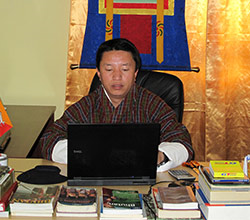The Paro Festival, also known as Paro Tshechu, is a vibrant and culturally significant religious festival celebrated annually in Paro, Bhutan. This festival holds a special place in the hearts of Bhutanese people and is one of the most anticipated events in the country. Tshechu means “tenth day” in Dzongkha, the official language of Bhutan, and the festival usually takes place on the 10th day of a specific month in the Bhutanese lunar calendar, which varies each year based on the lunar cycle.
The Paro Festival is a time of spiritual reflection, communal bonding, and joyous celebration. It is held in the courtyard of the Paro Dzong (fortress-monastery), a historic and picturesque structure that adds to the unique ambiance of the event. The Dzong is beautifully adorned with colorful silk hangings, intricate thangka paintings, and religious artifacts, creating a magnificent backdrop for the festivities.
The festival is primarily a religious event dedicated to Guru Rinpoche, also known as Padmasambhava, who is considered the second Buddha and the founder of Bhutanese Buddhism. The highlight of the festival is the performance of various cham dances, which are traditional mask dances representing the triumph of good over evil. These dances are performed by both monks and laypeople dressed in ornate costumes and vibrant masks that symbolize deities, demons, and mythical beings.
Throughout the Paro Festival, visitors and locals come together to witness the cham dances, listen to Buddhist teachings, and receive blessings from the religious leaders. The festival serves as a spiritual reminder and an opportunity for Bhutanese people to strengthen their faith and connection with their cultural heritage.
In addition to the religious activities, the Paro Festival is also a time for socializing, shopping, and enjoying traditional Bhutanese cuisine. Local vendors set up stalls around the Dzong, offering a variety of handicrafts, textiles, jewelry, and local delicacies. It’s a wonderful opportunity for visitors to immerse themselves in Bhutanese culture, interact with locals, and take home unique souvenirs.
The Paro Festival encapsulates the essence of Bhutanese identity, spirituality, and community. It offers a glimpse into the rich cultural tapestry of the country and showcases its deep-rooted devotion to Buddhism. Attending the Paro Festival is not only a visual and sensory delight but also a profound cultural experience that leaves a lasting impression on all who participate.
Festival provides the occasions for the community to get together
Visit to the capital city of Kingdom of Bhutan – Thimphu.
Explore and experience Bhutan’s unique culture.
Experience Bhutan’s Religious Festivals.
Be a part of biggest festival in Bhutan – Paro Festival.
Visit to the oldest monastery in Bhutan – Kyichu Lhakhang
Visit to the most important and sacred pilgrimage spot in the Buddhism world – Taktshang Monastery.
Witness and get blessing from the biggest and oldest Thongdrel Ceremony – Unfurling of Paro Thongdrel (Thangkha)
City tour to Paro, Thimphu and Punakha valley.
Day 01. Arrive to Bhutan – Trsnafer to Thimphu
The flight into Paro on our national carrier, Druk Air, is a befitting introduction to the spectacular beauty of our country. In clear weather, magnificent views of the world’s highest peaks like Gangkar Puensum, give way to the lush green Paro valley as you land. Your Bhutanese escort from Authentic Bhutan Tours- For Your Bhutan Experience! will warmly welcome & greet you on arrival, and then drive you to the Paro Rimpung Dzong, the center of civil and religious authority in this region. After this we will have lunch in the Paro town. Then we will drive to Thimphu, the capital city of Bhutan. The drive will take about 1 hour and 30 minutes along a river valley, past small villages and traditional farmhouses, through peaceful countryside. It’s a small & charming capital city located in the heart of the Himalayas. On reaching Thimphu, we will do a short hike, (Sangaygang Cross Country) Wangditse Hike. The hike starts from BBS tower till Dechenphodrang, through pine forest. From this hike we can see the Thimphu town (Capital City) beautifully. The hike will take about 1hour 30minutes. Evening visit Tashi Chho Dzong, seat of the national government and the Central Monastic Body, including the summer residence of the Je Khenpo (Chief Abbot of Bhutan) and stroll around Thimphu town. Dinner and overnight stay
Day 02. Thimphu Stay
Sightseeing in Thimphu, visit to Memorial Chhorten, built in 1974 in the memory of third king late Jigme Dorji Wangchuk, and the temple inside gives good examples of tantric Buddhist and its philosophy. Mothithang minizoo to see the National Animal of Bhutan (Takin), Zulikha Nunnery, the Thangtong Dewachen nunnery was founded in 1976 by Rikey Jadrel and today it houses the sixty nuns engaged in Buddhist study and practices. Folk Heritage Museum, this Folk Heritage Museum is a showcase, the 19-century farmhouse and the living style of the Bhutanese family. National Library, the National Library was established in 1967 to preserve many ancient Dzongkha and Tibetan texts. Lunch in Thimphu town. After lunch, visit Paper Factory, were Bhutanese Traditional Papers & paper products are made. Weaving Center produces hand-woven textiles on site and has a selection of cloth and ready-made garments for sale. This is one of the few places where you can watch weavers at work, and then Authentic Bhutanese handicrafts. Evening we will visit Bhutanese Farm House for dinner and Traditional Hot Stone bath. Over night stay at Thimphu Hotel or we can organize even in Bhutanese Farm House.
Day 03. Thimphu - Punakha
Today we will drive to Punakha Valley. We will drive over dochula pass (3150m). The pass is adorned with 108 small stupas and from this pass; we can see panoramic view of eastern Himalayan Mountains ranges on clear days. On reaching Punakha, we will visit the most beautiful dzongs in Bhutan, Punkha Dzong and lunch will be served at Punakha. After lunch we will visit Chhimi Lhakhang, which is located at a hilltop. We have to walk about 30 minutes from the road end till the lhakhang. The Lhakhang is known as ‘the temple of fertility’. Evening at leisure. Dinner and over night stay at hotel Punakha/Wangdi.
Punakha/Wangdi – Paro
After the early breakfast we will drive to Paro. The road ascends up to the great Dochula Pass. On the way back to Paro offers another chance to view the amazing Himalayan ranges. Stop along the way to take photos wherever you find the best spot for the photography. Lunch at Paro. After lunch we will enjoy with the Paro Festival. Dinner and over night stay at Paro Hotel.
Day 05. Paro Halt
Today we will go to the Paro festival ground at very early morning around 3:30AM to witness the Thongdrel Ceremony and get the blessing from Thongdrel. Thongdrel-is a big Thangkha. After the Thongdrel Ceremony, we will back to our hotel for breakfast and then we will take rest about 1hour 30minutes. Then we will hike to Paro Taktshang Monastery, the most famous and scared monastery in Buddhism world. Taksang means “Tiger Nest” named after Guru Rinpoche reportedly flew to this site riding on the back of a flying tigress late in the 9th century. We have to walk about 2hours up steep from the road end. The trail climbs through beautiful pine forest, many of the trees festooned with Spanish moss, and an occasional grove of fluttering prayer flags. Lunch will be served at Taktshang cafeteria. On our way back, drive to the village of Drukgyel and visit the ruins of Drukgyel Dzong, built in 1649 to commemorate the victory over Tibetan invasion and Kyichu Lhakhang, it is one of the two most sacred and the oldest temples in Bhutan, built in 7th century by Tibetan king Songtsen Gampo (the 33rd Tibetan king, who is also the manifestation of avoloketeshivara, commonly known to Bhutanese as Chenrize). Evening stroll around the Paro vally town, the valley of surpassing Beauty.Dinner and over night stay at Paro hotel.
Day 06. Paro - Airport
Today we will drive to Paro International Airport for your onward flight to Bangkok. Our representative will bid you farewell here at the airport. We wish you a very pleasant and comfortable journey back to your country. Thank you very much for visiting Bhutan through our company and we will always cherish your visit to Bhutan and we will always look forward to see you again in Bhutan – The Land of Happiness!
Thank You & Tashi Delek!
Start planning your tailor-made Dream Holiday to Bhutan – The Land of happiness!
In order to experience the best and rewarding fulfillment clients must plan in advance the different logistics that you have in your minds before actually venturing into the world of trips. You might have wishes and hopes for which you need to plan.
The following information will help you to plan your dream trip to Bhutan.
1. When and how to visit Bhutan?
Choose your traveling date like Arrival/Departure date. You also need to choose entry/depart Bhutan via AIR or LAND.
By Air: Druk Air, the national carriers is the only service operator in the kingdom and operates several flights per week from Bangkok (Thailand), Delhi & Kolkata (India) and Kathmandu (Nepal) to Paro (Bhutan). The Paro International Airport is located about an hour and a half drive from Thimphu, the capital city of Bhutan.
Paro airport is daylight restricted, and the flights are totally dependent on the weather. As a result, sometimes flights are delayed. It is therefore a good idea to keep at least 24 hours of transit time for connecting flights out of Paro. You might also want to consider traveling on a non-restricted ticket so that if you miss a connecting flight, you can be rerouted or seated on the first available carrier.
Sometimes flights into Paro are disrupted because of unfavorable weather conditions. If this occurs, the flight will stop for the night at the transit airport. To be prepared, you may want to carry your essential personal items in your carry-on luggage.
By Land: Phuentsholing, a Bhutanese town in the southwest has road access to India. It is located about 170 km from the Indian domestic airport at Bagdogra, West Bengal. Phuentsholing is about 172 km from Thimphu the capital city of Bhutan and is about 6hours drive distance. And S/
2. What are your itineraries?
All the tours can be customized and extended as per our valued client’s requirements. There are sample itineraries for your kind reference and it will give you some general idea of the likely trip scheduled.
Complete the tour request form and submit it to us. Send us correct name list. We will send you the flight reservation status via email.
After confirming your reservation, we need the scanned copy of member’s passport.
Please remit us full payments and send us the copy of remittance paper via email. Visa will not be accepted without full payment.
We will send you the flight ticket copy and Visa Clearance Copy prior to your departure to Bhutan via email. You need to print out and carry along with you.
Start packing and looking forward to have a memorable trip in the LandThunder Dragon, DrukYul.
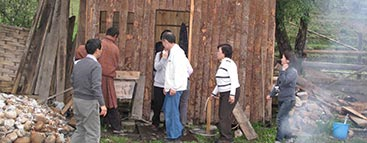
Hot stone bath (Dhotsho) is a traditional bath of Bhutan, where a tradition of heating up stones and then soaking in the water that is in turn heated by the stones. This is also a curative method and is used throughout the country We Bhutanese belief that this bath has so much of medicinal benefits. Some diseases are curable-like joint pains, hypertension, stomach disorder, arthritis and many other minor diseases. Especially for the old age, where we have lots of body pains, joints pains helps a lot by this Hot Stone Bath (Dhotsho).
I think, the minerals in the rocks have certain chemicals, which can cure certain disease of our body. Hot stone bath has no side effects. It is in its pure natural form. We can organize the hot stone bath during your stay in Bhutan.
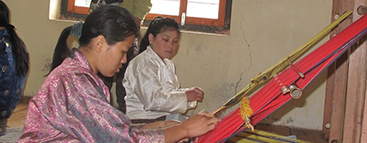
The Bhutanese textiles are rich, vibrant, and colorful and are a complex art form as well as an integral part of the Bhutanese culture. This Bhutan weaving experiences will give you an insight about the rich textiles in Bhutan. You can sit one of the handlooms of Bhutan and weave your self practically. We promise that you will really enjoy this with great satisfaction in your life.
We will also see or learn the natural coloring and dyeing. You can bring your own materials like handkerchief to dye and color. So visit Bhutan and experience it practically by yourself.
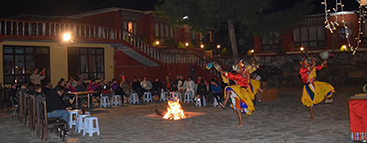
Folk Performing Arts & Music in the Himalayan Kingdom of Bhutan
We have Cultural Program Performing groups, which they will perform like Traditional folk songs, dances and keeps original tunes and dances alive. Moreover, new choreography for some traditional and regional songs is sometimes developed.
The troupe also performs mask dances that have historical and spiritual significance.
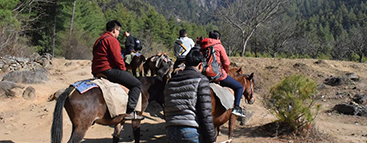
Tiger’s Nest is most visited spot in Bhutan and it is much awaited by every tourist who visits Bhutan to climb to Tiger’s Nest.
It takes about 2 hrs 30mins up steep climb through the forest of pine, oak and Rhododendron. However you can ride the horse and climb till the Taktshang cafeteria.



